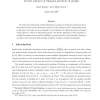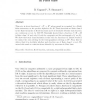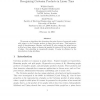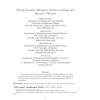101 search results - page 7 / 21 » Grundy number and products of graphs |
DAM
2008
13 years 7 months ago
2008
We study the combinatorial problem of finding an arrangement of distinct integers into the ddimensional N-cube so that the maximal variance of the numbers on each -dimensional sec...
COMBINATORICS
2000
13 years 7 months ago
2000
Let (G) denote the domination number of a graph G and let G H denote the Cartesian product of graphs G and H. We prove that (G)(H) 2(G H) for all simple graphs G and H. 2000 Math...
ITA
2007
13 years 7 months ago
2007
This note is about functions f : Aω → Bω whose graph is recognized by a B¨uchi finite automaton on the product alphabet A × B. These functions are Baire class 2 in the Bair...
DM
2007
13 years 7 months ago
2007
We present an algorithm that determines the prime factors of connected graphs with respect to the Cartesian product in linear time and space. This improves a result of Aurenhammee...
CPC
2007
13 years 7 months ago
2007
The strong isometric dimension of a graph G is the least number k such that G isometrically embeds into the strong product of k paths. Using Sperner’s Theorem, the strong isomet...




